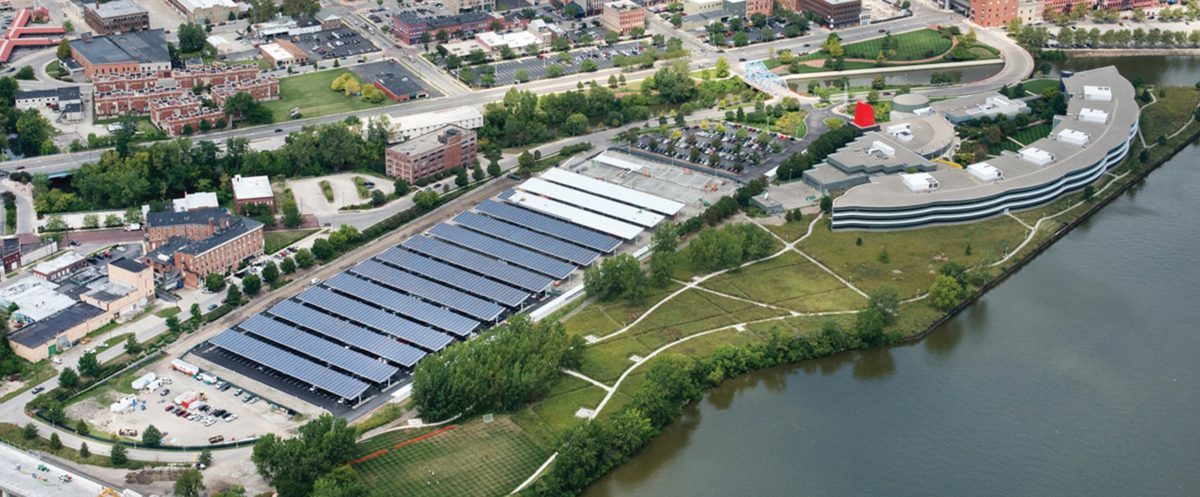Five prominent firms with operations in Ohio are endorsing a report advocating 2.2 gigawatts (GW) of solar for Ohio by 2030, lending their corporate logos in support.
“The U.S. energy industry is undergoing a transition toward clean energy,” said JPMorgan Chase executive Matthew Arnold in the report’s foreword. He noted that his company “has seen firsthand an increase in investments in sustainability. Individual states have a unique opportunity to encourage, and benefit from, this evolution.” His firm is developing 20 MW of solar at its corporate center in Columbus, Ohio, he said.
Other “logo-level” backers are Owens Corning, Walmart, Eaton, Whirlpool, and Ohio-based GEM Energy. Advisory council members include these firms plus Procter & Gamble, EDP Renewables, and the Ohio Manufacturers Association.
Reaching 2.2 GW of solar in Ohio would involve $3.6 billion in investment, and “sustain 800 direct jobs and over 1,700 indirect and induced jobs each year,” said the report, and would boost the state GDP by $1 billion per year.
As of July 2018, Ohio had 176 MW of installed solar, and four solar projects under development totaling 550 MW.
The report highlights First Solar’s 600 MW solar panel factory in Perrysburg, Ohio, and its nearby 1200 MW factory now under construction, which together will employ 1250 people. Two in-state manufacturers of racking and mounting hardware are also featured.
The report conveys pride in the state’s manufacturing strength, as it ranks third in the nation in manufacturing jobs, has 34 accredited engineering programs, graduates 20,000 students per year in the STEM fields (science, technology, engineering and math), has “150 apprenticeship programs to train Ohioans to be machinists,” and “supports over 11,000 registered apprentices in construction.”
To derive the 2.2 GW solar target, the report’s author Synapse Energy Economics first ran the Regional Energy Deployment System (ReEDS) model, developed by the National Renewable Energy Laboratory. Synapse, however, developed its own solar projection, “because recent demonstrated commercial interest in utility-scale solar development in the state has far exceeded what ReEDS projects for development.”
The report also makes recommendations regarding wind power, electric transportation, energy efficiency, and grid modernization.
The report invites “Ohioans with diverse perspectives” to “join the conversation” at the report’s website.
Synapse Energy Economics prepared the report in partnership with the Great Lakes Energy Institute at Case Western Reserve University, with support provided by Environmental Defense Fund.
Technical note: Synapse Principal Associate Asa Hopkins explained how the 2.2 GW solar target was derived: “The 2.2 GW is composed of 1.2 GW of utility-scale PV and 1 GW of distributed generation (DG). The potential DG PV value was derived based on growth of about 30 MW per year rising up to 80 MW per year by 2023, then continuing at that level. Recent DG growth in Ohio has been about 30 MW per year, and we expect increases in the pace of solar deployment are possible with falling component costs (and possibly contingent on changes in Ohio policies and further maturation of the market).
“We modeled the utility-scale PV as more near-term, encouraged by the expiring ITC. There are 550 MW of large projects that are either approved or proposed (filed with the Siting Board), in addition to about 60 MW of operating projects, and we conservatively estimated that at least this many projects again could be constructed before 2030.”
This content is protected by copyright and may not be reused. If you want to cooperate with us and would like to reuse some of our content, please contact: editors@pv-magazine.com.



5 comments
By submitting this form you agree to pv magazine using your data for the purposes of publishing your comment.
Your personal data will only be disclosed or otherwise transmitted to third parties for the purposes of spam filtering or if this is necessary for technical maintenance of the website. Any other transfer to third parties will not take place unless this is justified on the basis of applicable data protection regulations or if pv magazine is legally obliged to do so.
You may revoke this consent at any time with effect for the future, in which case your personal data will be deleted immediately. Otherwise, your data will be deleted if pv magazine has processed your request or the purpose of data storage is fulfilled.
Further information on data privacy can be found in our Data Protection Policy.